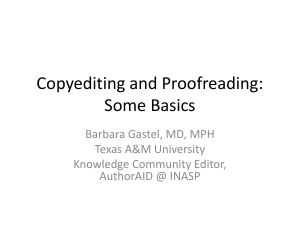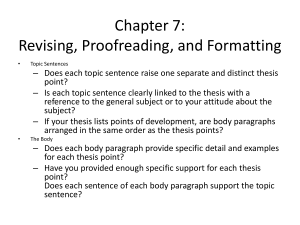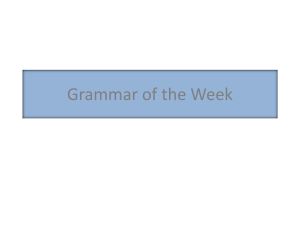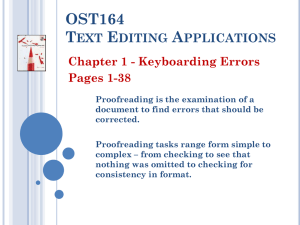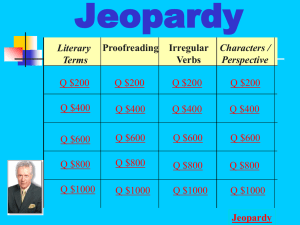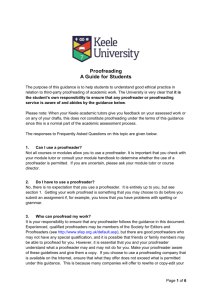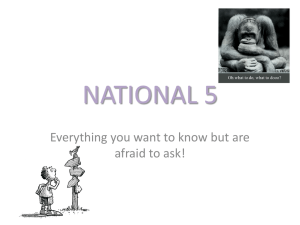proofreading-tips-and-techniques
advertisement
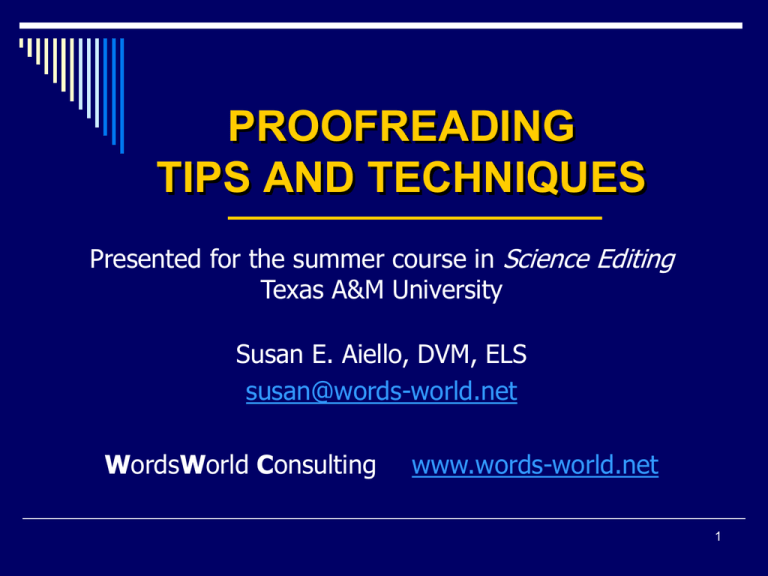
PROOFREADING TIPS AND TECHNIQUES Presented for the summer course in Science Editing Texas A&M University Susan E. Aiello, DVM, ELS susan@words-world.net WordsWorld Consulting www.words-world.net 1 International Postage Rage Increase The Post Office will increase their international rates, effective 12:01 A.M. on July 9. Letters weighing no more than ½ oz. for Canada and Mexico will be .46 and .40 respectively, while letters weighing no more than 1 oz. for Canada and Mexico will be .52 and .46. All other countries will cost .60 for letters that weigh no more than ½ oz., and $1 for letters that weight no more than 1 oz. For more information, call your site Mailing Services. Talking about a sleep disturbance side effect: “the low-doze response” In an article about petroleum toxicity: “pope dope” Column head in a table about the competitor’s drug: Patient Expiration Date 2 3 Basic Techniques: Comparison Proofreading Direct word-by-word comparison of “dead” copy (previous version) with “live” copy (new version) “Live” copy should reflect any changes made to “dead” copy Ensure no new errors introduced Can be done solo or as a team 4 Comparison Proofreading: Solo Most common method Slowest Cheapest Best for short copy or special type (eg, mathematical formulas) 5 Comparison Proofreading: Team Fastest Most expensive Most accurate for tables, long lists of numbers, dead copy that is hard to read Must read everything – words, punctuation, type description (caps, underline, bold, etc), changes in spacing, changes in indentation Clear enunciation, steady, near-monotone, softspoken to lower fatigue Can use tape to do yourself, but time disadvantage 6 Basic Techniques: Noncomparison Proofreading No “dead” copy Most commonly an electronic file “Dead” copy is available, but only “live” copy is read word for word Note: Proofing on screen vs on hard copy affects both accuracy and speed! 7 Noncomparison Proofreading Fast Cheap Editorial questions may be unanswered Is document complete? Are data accurate? Are proper names spelled correctly? Lower accuracy Easy to miss mistakes, eg, “not” guilty 8 Noncomparison Proofreading For scientific, medical, or legal material, the proofreader should be knowledgeable in the subject matter; if he or she is not, the material should also be reviewed by a subject matter expert. Many journals leave final responsibility for accurate live copy with author. 9 Basic Techniques: Proofreading versus Copyediting Proofreaders have a limited level of authority. Usually, proofreaders are not subject matter experts. Authors and editors retain the authority to decide on changes. 10 Basic Techniques: Proofreading versus Copyediting Copyeditors Correct an author’s work Prepare document for next stage in publication process Proofreaders Correct keyboard operator’s work Correct compositor’s work 11 Obstacles to Good Proofreading Failure to differentiate from editing Electronic age, the Internet, e-mail Track Changes Time constraints, ie, the need for speed Distractions, eg, visual, sound, etc 12 Complicating Factors Length and technical level of document Tables Figures and legends References Type size, font, and quality Electronically regenerated copy New copy Rekeyed copy Deleting or adding copy (resulting in more or less space) 13 Characteristics of Good Proofreaders Excellent memory and ability to concentrate Familiar with relevant editorial style Exercise good judgment whether to mark, query, or ignore Exercise good judgment and sensitivity as to different stages of copy, deadlines, other requirements A proofreader who is also the copyeditor should follow these same guidelines (with greater level of authority). 14 Characteristics of Good Proofreaders Excellent spelling ability Thorough understanding of grammar, punctuation, and sentence structure Understanding of typographic detail; technical knowledge about type, page design, printing, etc 15 Approaching a Proofreading Project Project deadline Level of authority assigned or expected Nature of the document Stage of the copy Previous reviews Others involved later in the process (eg, who will respond to queries, produce clean copy, proofread next version) 16 Proofread for ─ Deviations from dead copy (if comparison proofread) Inconsistent editorial style punctuation capitalization Number style abbreviations units of measure. use of italics, bold, etc references Sequence errors (alphabetical and numerical) 17 Proofread for ─ Typos (omissions of letters, transpositions, etc) Missing or repeated words or lines Nonstandard grammar or poor exposition (eg, incomplete sentences, obvious omissions or discrepancies) Incorrect math Errors in equations and formulas, including symbols Errors in headings, captions, etc Errors in references (eg, callout does not correspond) Errors in tables, graphs, charts (both text and graphics) 18 Proofread for ─ Type specifications/type style errors Formatting misalignment spacing errors (eg, line, word, or letter spacing; note justification) line breaks, word division errors positioning faults (eg, uneven placement of running heads, page numbers, etc) 19 Proofread for ─ Missing material (pages, tables, illustrations, graphics) Blanks in text (where items are to be inserted) Mechanical faults (smudges, uneven ink color, registration, type quality, etc) 20 Proofread a Second Time Don’t read for sense Try different methods and find a system “Read” backward Read lines from bottom of page up Read lines from middle to the end, and then from the beginning to the middle 21 Myiasis caused by larval stages of Cochliomyia hominivorax is one of the most important ectoparasitic problems in the New World. It affects domestic and wild animals, including people, in the tropical and subtropical areas of Latin America. It is found from southern Mexico to northern Argentina. Economic losses are difficult to estimate, but different authors have given annual values varying from US $100 to US $330 million (Baumhover, 1966, Horn, 1987). Female flies lay eggs on dry areas around fresh wounds. The eggs hatch quickly and, under proper climatic conditions, the parasite can complete its life cycle in about 21 days (FAO). If the parasite population is high and preventive treatment is not undertaken, most of the castrated, dehorned or newly born calves may suffer myiasis. Untreated, the calves may die, or weight gain will be severely depressed. In late spring/summer, flies can be so numerous that some common practices, such as castration and dehorning, are delayed until colder temperatures reduce the fly population. 22 Myiasis caused by larval stages of Cochliomyia hominivorax is one of the most important ectoparasitic problems in the New World. It affects domestic and wild animals, including people, in the tropical and subtropical areas of Latin America. It is found from southern Mexico to northern Argentina. Economic losses are difficult to estimate, but different authors have given annual values varying from US $100 to US $330 million (Baumhover, 1966, Horn, 1987). Female flies lay eggs on dry areas around fresh wounds. The eggs hatch quickly and, under proper climatic conditions, the parasite can complete its life cycle in about 21 days (FAO). If the parasite population is high and preventive treatment is not undertaken, most of the castrated, dehorned or newly born calves may suffer myiasis. Untreated, the calves may die, or weight gain will be severely depressed. In late spring/summer, flies can be so numerous that some common practices, such as castration and dehorning, are delayed until colder temperatures reduce the fly population. 23 Standard Proofreaders’ Marks Universally understood Used to mark errors in text and format, ie, moving type and space Must be legible Use different color ink than text on page No pencil! No red ink! 24 Standard Proofreaders’ Marks Mark errors twice in the text to indicate the location of the correction in the margin to show the correction itself If multiple errors, mark from left to right, separating marks by slashes Use both margins 25 Standard Proofreaders’ Marks Italics vs underline Circle all instructions and explanations to indicate that the instruction is not to be typeset Cross out with a single line so that the deletion can be seen and read 26 Standard Proofreaders’ Marks He had cute appendicitis. 27 Standard Proofreaders’ Marks He had a cute appendicitis. He hada cute appendicitis. 28 Standard Proofreaders’ Marks The epiploic foramen is a natural opening bounded by the caudate lobe of the liver, the portal vein, and the interior vena cava. Linus Pauling lived to be 93 years odd. Einstein’s principal of equivalence states that it is impossible to distinguish between an inertial force and a gravitational one. 29 Standard Proofreaders’ Marks Gingival growths are usually relatively insensitive and have the density of connective fibrous tissue. Its’ associated with diffuse inflammatory infiltrates in the lungs and a pronounced peripheral eosinophilia. What is it? Its pulmonary infiltration with eosinophilia (PIE syndrome.) 30 Standard Proofreaders’ Marks Proteolytic enzymes from the stomach and pancreas degrade protein into shortchain oligopeptides, dipeptides, and proteins amino acids. 31 Standard Proofreaders’ Marks Proteolytic enzymes from the stomach and pancreas degrade protein into shortchain oligopeptides, dipeptides, and proteins stet amino acids. 32 Standard Proofreaders’ Marks Proteolytic enzymes from the stomach and pancreas degrade protein into shortchain oligopeptides, dipeptides, and proteins stet amino acids. 33 Queries Misspellings (if unsure or cannot verify) Incorrect arithmetic (Note: If column of numbers does not add up, must determine which number[s] is incorrect.) Blatantly bad grammar – not style (only if it would embarrass author or editor) Illogical statements (eg, 33-week vacation) Inconsistent editorial style, including punctuation 34 Queries Write in margin on live copy Post-it™ notes – can fall off, suggest record page number on note Query list – ask author whether acceptable; list should be typed Don’t edit or rewrite! 35 Queries Specify location of problem Indicate nature of problem If necessary, explain why it is a problem. Example: “Compare to pg 7, line 17. Different acronym used. Should it be the same?” “Is this OK?” is not a good query. “?” is even worse. 36 Proofreading Tables Check everything checked in regular text Try different methods and find a system Proof column heads Proof stub Proof columns Proof rows Spacing and alignment align columns according to content left, center, decimal points, en-dashes 37 Proofreading Tables Use of rules and straddle rules Arithmetic verify calculations transposition slide errors, ie, numerals mistakenly added or omitted Consistency in editorial style Footnotes – callouts in tables go left to right and top to bottom 38 Frequent Errors Omissions and repetitions, esp at beginning and end of of lines Headlines, titles, headings, etc Not using a spell checker Depending on a spell checker errors that spell other words (eg, food/foot, its/it’s) words that sound alike, but are spelled differently and have a different meaning (eg, there, their) two-letter words (eg, in, it, if, is) 39 Proofreading Method Proof separate items separately and use a checklist! Much easier and much faster to proof for a specific item on all pages than it is to proof for all items on each page. Combining tasks leads to errors. Make a list of each item and check off as you complete. 40 Proofreading Method Headings and subheadings Running heads Table of contents – sequence, accurate page numbers Text Tables, figures, references – sequence and format consistency Graphic elements Page numbers (folios) – sequence, accuracy in references Consistency of styles (specification [spec] sheet) 41 Proofreading Other Typeset Elements Line breaks: hyphenation Page breaks: watch for subheads at bottom of page Orphans: single word on a new line Widows: single line on a new page (or column) 42 Proofreading Other Typeset Elements Long ladders (stacks of line-end hyphens) and knotholes (identical characters stacked up on consecutive lines) are never desirable. How many stacked hyphens are acceptable varies among publishers and type shops and depends on the width of the line measure. Standards for blocks vary with the number of characters and lines involved. They also vary with the typographic factors such as line width and line spacing and are often a matter of judgment rather than of rule. 43 Proofreading Other Typeset Elements Rivers: vertical white spaces that meander vertically down the page Lakes: “pools” of white space interspersed throughout text 44 Proofreading Other Typeset Elements The Crime Crime Control Act of 1973 (Public Law 93-83). This Act further refined L.F.A.A.’s administrative structure, revised block and discretionary funding require-ments, expanded the role of the National Institute of Law Enforcement and Criminal Justice, and added security and privacy guidelines to safeguard criminal history information. 45 Proofreading Other Typeset Elements The commission, an independent agency of 12 members of Congress and 3 executive branch officials who evaluate and encourage compliance with the 1975 agreement signed by 35 nations, held hearings Wednesday and yesterday on the human rights guarantees of individual “freedom to practice and profess… religion or belief” and “of equality before the law” for minorities. 46 Proofreading Other Typeset Elements Letterspacing letters within words generally separated from each other by the same amount of space watch especially for large display type in all caps (headlines, titles, etc) certain combinations of letters need kerning (eg, AV) 47 Proofreading Other Typeset Elements Letterspacing 48 Proofreading Other Typeset Elements Letterspacing 49 Proofreading Other Typeset Elements Tracking: space between words normal word spacing is about one-third of an em all word spacing in a single line should be the same watch especially when text is justified Leading: space between lines of type measured in points 50 Specific Proofreading Tips Read aloud (or whisper) to yourself. Improves accuracy because it forces you to look at every word. Place your finger on each word to slow yourself down. Concentrate on one line at a time (use a ruler or index card). Put it away, and try again later. Adjust the effort to the job (coffee-machine memo vs annual report). 51 More Tips for the Serious Proofreader Ensure you have adequate room (enough for four stacks of paper) and good lighting. Eliminate distractions (eg, people traffic, talking, radio, TV, children, spouses…). Proof on an inclined surface – much less fatiguing. Invest in a good sleep pillow. Break every hour and look into the distance; take a walk. 52 More Tips for the Serious Proofreader An Exercise to Reduce Eyestrain – “The Distant Night Exercise” Cup your hands and place your palms over your eyes. Position your hands so that no light is coming through. Your palm can touch your eyelashes, but do not put pressure on your eyes. As long there is no light coming in, you can keep your eyes open or closed. Now, relax and imagine that you're looking into the distant night sky. After 30-60 sec, the eyestrain should be less. 53 More Tips for the Serious Proofreader Keep words and lines aligned – move the paper as needed to accommodate. Tack copy on wall and stand back to look at headlines, titles, spacing, etc. Look at copy upside down and sideways to find spacing errors and misalignments. 54 More Tips for the Serious Proofreader If possible, ask someone else to proof also, especially if it’s your own copy. With our own copy, we tend to see what we “know” is there, rather than what really is there. Print copy in a different font, a different line length, or on a different color paper (good for text only, not page layout or spacing). 55 Proofreading Producing quality documents/publications takes a lot of time, effort, and expense. Key step in review process Proofreader may be last person to see document before publication Quality and credibility 56
